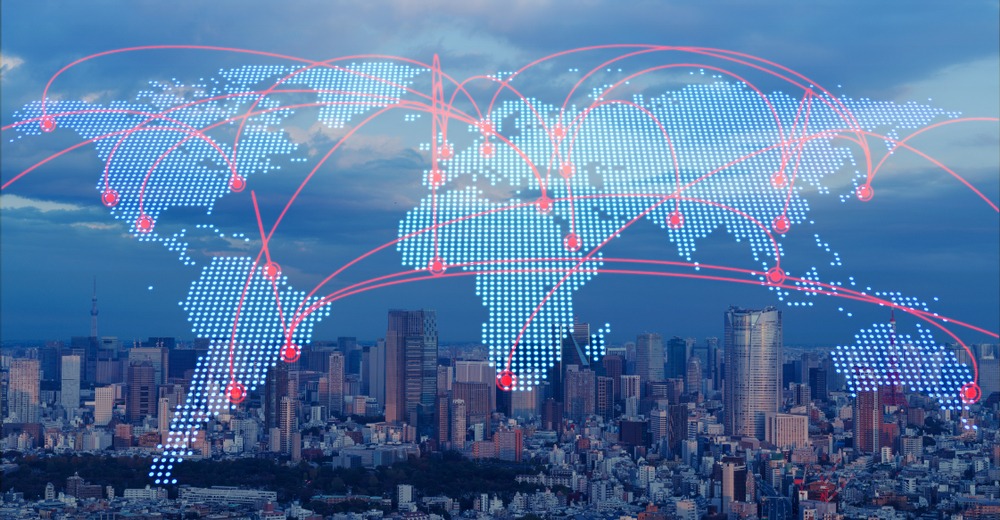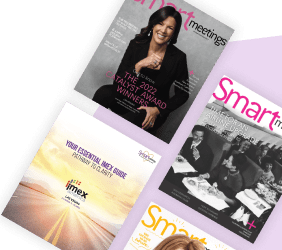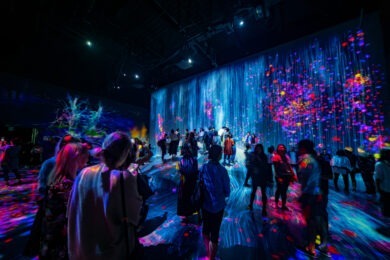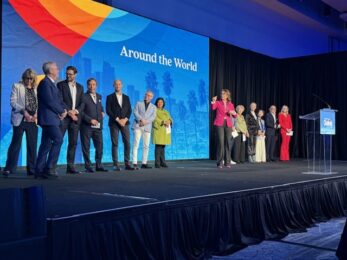When policies close doors, technology opens windows
In a beautiful garden under the soft Portland sun in 2009, I stood in my wedding dress, exchanging vows with my soon-to-be husband. The ceremony was perfect in many ways – unusually sunny and warm for Portland weather—yet profoundly incomplete. Missing from the gathering were some of the most important people in our lives—our parents from Romania and Spain, denied visas to enter the United States for this once-in-a-lifetime milestone.
What should have been a devastating blow became instead our first lesson in technological inclusion. We set up a livestream—rudimentary by today’s standards—bringing our ceremony and reception into living rooms across continents. As we exchanged rings, tearful parents watched from thousands of miles away, connected through pixels and perseverance.
Sixteen years later, this personal experience resonates with uncomfortable relevance as our industry faces a rapidly shifting landscape under the current administration. New border restrictions, visa policies, and international perception challenges are creating barriers reminiscent of what my family experienced, but on an industry-wide scale. What was once my personal workaround has become an essential strategy for maintaining global connections in an increasingly restrictive environment.
The Current State: March 2025
The political climate of early 2025 has created a challenging environment for international participation in U.S.-based events:
- Visa appointment wait times have reached unprecedented levels, with 849 days in Mexico City, 640 days in Bogotá and 499 days in Mumbai—timeframes that make meaningful planning virtually impossible.
- The State Department recently removed its online visa wait time tracker, eliminating transparency for applicants and creating additional uncertainty for event planners trying to forecast international attendance.
- In February 2025, an executive order introduced measures affecting public sector travel, requiring centralized approval for non-essential travel including conferences and professional development.
- Several countries including Canada, the UK, Germany, Denmark, and Finland recently issued updated travel advisories after incidents of travelers being detained or denied entry at U.S. borders.
- Proposed policies affecting travel from over 40 countries are under consideration, creating a hesitancy that extends far beyond the directly impacted nations.
These aren’t just policy abstractions—they’re already reshaping attendance patterns. Canadian inbound travel experienced a 4.4% year-over-year drop this February. European countries show similar trends, with travel from Switzerland down 10.3%, Slovenia down 8.6%, and Belgium down 7.9%.
Read More: Weaponization of Travel: Navigating Cultural Obstacle Courses
Industry associations emphasize these concerns represent practical challenges to our sector’s global reach rather than political positions. As Nicola Kastner, CEO of Event Leaders Exchange, recently noted, “This is not a political statement. It’s a call to awareness.“ After spending years rebuilding from the pandemic, we now face a new set of obstacles that threaten the stability and international character of U.S.- based events.
The Dual Attendance Crisis
For event professionals in 2025, we’re witnessing a dual attendance crisis:
- Federal and Public Sector Attendees: The February 2025 executive order has significantly curtailed government employee travel. Some agencies, including the Department of Health and Human Services, have suspended nearly all travel for their staff. When public sector attendance drops, events lose crucial regulatory perspectives and subject matter expertise, particularly in sectors like healthcare, education, defense, and infrastructure.
- International Attendees: A combination of visa processing delays, symbolic policies, and travel advisories are contributing to reduced global participation. The U.S. Travel Association warns that a 10% drop in Canadian visits alone could result in 2 million fewer visitors, $2.1 billion in lost spending, and 14,000 U.S. jobs lost.
At CES 2025 in Las Vegas, Chinese exhibitors were denied U.S. visas despite invitations. While about 1,300 Chinese companies exhibited, this was down from the record 1,551 in 2018. The Consumer Technology Association publicly urged the U.S. government to expedite visas for legitimate business travelers, stating that visa woes are “disappointing and costly” for global trade shows.
My 2009 Wedding: A Relevant Parallel for 2025
In 2009, when my parents and in-laws couldn’t attend our wedding due to visa issues, we faced a similar challenge: how to maintain meaningful connection across boundaries that weren’t of our making.
Our solution then feels eerily prescient now. Using the limited technology available, we created a bi-directional experience. Our families didn’t just watch; they participated. They dressed formally, gathered with extended family and friends, ate meals timed with our reception, and even made toasts that we played at our venue.
This wasn’t just about transmission—it was about creating agency and inclusion despite physical absence. We didn’t view streaming as a lesser experience, but as a different, parallel way of being present.
From Personal Solution to Industry Imperative
In 2025’s political climate, this approach has evolved from personal workaround to industry imperative. The current challenges require us to view hybrid solutions not as pandemic-era necessities but as strategic inclusion tools in response to policy-driven barriers.
Modern technology allows us to go far beyond what was possible in 2009:
- Multi-language support with real-time AI translation addresses language barriers
- Sophisticated engagement platforms create meaningful interaction rather than passive viewing
- Virtual networking spaces simulate the serendipitous connections of in-person events
- Content accessibility extends beyond the live event, creating ongoing value
- Regional satellite hubs allow for physical gatherings that connect to the main event virtually
These aren’t just technical features – they’re diplomatic bridges across newly erected barriers.
Strategic Adaptation: Innovative Approaches for 2025’s Realities
While industry groups continue advocating for policy changes, event professionals need immediate strategies that address current realities:
- Attendance forecasting matrix: Develop a multi-variable projection system that accounts for geographic factors, visa processing timelines, and sector-specific travel restrictions. This allows for more nuanced planning than simple percentage reductions.
- Visa navigation resources: Create dedicated support systems for international registrants with country-specific guidance, estimated processing timelines, and direct connections to expediting services where available.
- Experience equity planning: Rather than treating virtual attendance as a lesser option, approach programming with a “digital-first” mentality that ensures every meaningful in-person interaction has a compelling virtual counterpart.
- Ambassador programs: Establish regional representatives who can facilitate local gatherings that connect to your main event, creating physical touchpoints for those unable to travel to the U.S.
- Contractual flexibility: Renegotiate venue and vendor contracts with specific clauses addressing international attendance fluctuations, reducing financial exposure to policy-driven attendance shifts.
- Content stratification: Design programming that distinguishes between what must be experienced synchronously versus what can be accessed asynchronously, maximizing flexibility for international participants across time zones.
- Diplomatic channels: Partner with international chambers of commerce and industry associations who may have established pathways to facilitate business travel even amid broader restrictions.
Looking Forward While Acknowledging the Present
The visa and travel challenges our industry faces in March 2025 are not temporary inconveniences – they reflect fundamental policy shifts. Waiting for a return to “normal” isn’t a viable strategy.
Instead, we must acknowledge the reality of these new barriers while innovating ways to maintain global connection despite them. As event professionals, our responsibility isn’t just to produce gatherings; it’s to ensure that meaningful connection happens regardless of political context.
When I think back to my wedding day, I remember both the joy of our ceremony and the bittersweet knowledge that our parents were watching from afar. Technology didn’t solve the visa problem, but it created a pathway for presence and participation that wouldn’t otherwise have existed.
Today, as our industry navigates similar challenges on a larger scale, we have an opportunity to demonstrate the same resilience and creativity. Yes, joining online is not the same as joining in person – but joining online is better than not joining at all. And with today’s technology, we can make that online experience far more meaningful than my wedding livestream in 2009.
The tools have evolved dramatically. The principle remains the same: when policies close doors, technology opens windows. And sometimes, those windows provide views we wouldn’t otherwise have seen.
—
 Anca Platon Trifan is a senior manager of strategic event technology and AI partnerships for Meetings & Incentives Worldwide with 20 years of experience in the event technology and AV production industry.
Anca Platon Trifan is a senior manager of strategic event technology and AI partnerships for Meetings & Incentives Worldwide with 20 years of experience in the event technology and AV production industry.
They bring a unique perspective on technical solutions for human connection challenges based on both professional expertise and personal experience.




